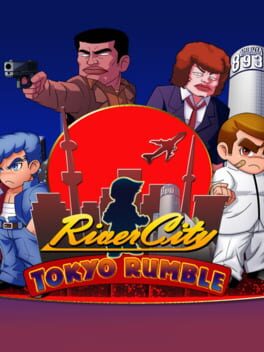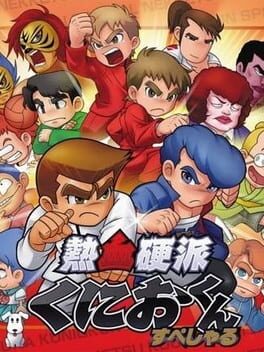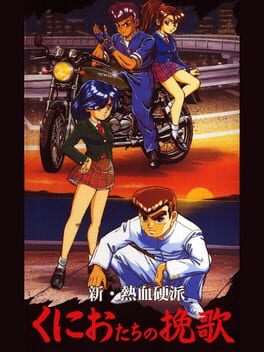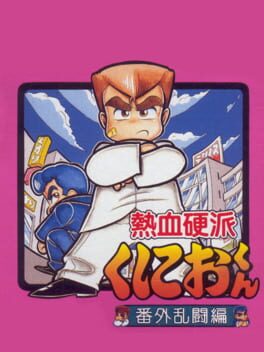Hiroshi is a student at Nekketsu High School, and is always bullied by everyone. One day, one man arrives at the school who changes everything. His name is Kunio!! Fighting the bullies! He looks tough, but he is a kind-hearted man. Kunio and Hiroshi become close friends. However, one day Hiroshi is kidnapped by someone. Kunio stands up and faces the gangs at Nekketsu High School to rescue his friend.
Also in series
Reviews View More
Way better than it should be as the first beat 'em up with belt scrolling.
I liked the graphics - all the characters and stages look cool, and those little cutscenes where Kunio's friend Hiroshi gets beaten up is the cherry on top.
The combat does feel a little stiff, but the moveset is great: you have combo punches, back kicks, jump kicks, dash and dash punches. You can grab stunned opponents and knee-bash them or throw over the shoulder. You can finish fallen guys with punches and even get grabbed from behind and break free. Also buttons define the direction of your attacks rather than the type, which I find really intuitive.
As for the challenge - it's hard as hell, especially the last stage with one-hitting yakuza guys. After numerous tries I barely managed to finish the first loop, and then found out I was playing on Normal.
Might be not the best beat 'em up to get into today, but impressive for 1986.
I liked the graphics - all the characters and stages look cool, and those little cutscenes where Kunio's friend Hiroshi gets beaten up is the cherry on top.
The combat does feel a little stiff, but the moveset is great: you have combo punches, back kicks, jump kicks, dash and dash punches. You can grab stunned opponents and knee-bash them or throw over the shoulder. You can finish fallen guys with punches and even get grabbed from behind and break free. Also buttons define the direction of your attacks rather than the type, which I find really intuitive.
As for the challenge - it's hard as hell, especially the last stage with one-hitting yakuza guys. After numerous tries I barely managed to finish the first loop, and then found out I was playing on Normal.
Might be not the best beat 'em up to get into today, but impressive for 1986.
Kunio-kun é basicamente o primeiríssimo beat 'em up em oito direções e o irmãozinho caçula de Double Dragon que ninguém liga. Eu curto muito a estética de delinquente japonês desse período e descobrir recentemente pelo YouTube que esse jogo era possivelmente finalizável em uma duração de míseros 6 minutinhos me fez querer joga-lo na mesma hora.
É realmente impressionante ver o quanto esse jogo fomentou as bases desse gênero, tanto que posteriormente a mesma Technos reaproveitaria muita coisa daqui no Renegade e na própria franquia Double Dragon que também foram muito importantes no gênero. O cenário urbano, as gangues delinquentes e criminosas, as mecânicas de correr, dar voadora, agarrão e finalização, os inimigos distintos em cada fase tais como os típicos motoqueiros de beat 'em up, e até mesmo o boss final com uma arma de fogo, tudo isso já estava aqui.
Bem interessante ver a visão que o jogo já tinha, mas também é notável o que se aprende a não reproduzir deste jogo. Um beat 'em up de menos de 10 minutos parece tranquilo, certo? Não tanto quando você só tem apenas uma única vida. É até engraçado como o jogo inteiro vira um grande tentativa e erro por causa disso, você tem vários inimigos em cada fase e quando sobra apenas três deles aparecerá um boss, mas a parte divertida é que o boss ENTRA nos capangas e não é fácil acertar dois de uma vez. Nisso o certo seria eliminar todos na tela, mas cada fase permite apenas dois minutos de duração, então você tem que ser rápido. Depois de uns bons game overs na conta você entende que tem que saber eliminar os inimigos adequadamente escolhendo primeiro os armados, mas tentar fazer isso tudo em apenas dois minutos é dolorido. O cúmulo disso é a última fase em que absolutamente qualquer golpe é hit kill, e até você descobrir é mais um game over. Ao menos perceberam o quão descabido isso era e deram uma vida extra se você passar da primeira parte da última fase, e o último boss curiosamente é o mais fácil.
Ainda dentro das inspirações em Double Dragon, este jogo já tinha o mesmo sistema utilizado em Double Dragon 2, então se você apertar o botão A você bate na esquerda, se você apertar o botão C você bate na direita, mas se você apertar um enquanto está apertando o outro, você basicamente dará um chute por trás. É uma mecânica até bem interessante e criativa pra época e não acho que envelheceu tão mal, é algo pensado justamente para controlar quando você estiver sendo atacado pelas costas, porém é mais uma coisa pra você aprender depois de um tempo.
É sofrido de jogar hoje em dia e eu tive que apelar pra save state e até vídeo no YouTube... Tipo, novamente na questão de tentativa e erro, nenhuma fase tinha parede com excessão da terceira fase, aí pra você derrotar o boss nessa fase você precisa quicar na parede depois de correr e meter um chute quando o boss te perseguir, só não sei como eu iria adivinhar em dois minutos, e isso depois de tomar game over por descobrir na prática que o boss era invulnerável a golpes e voadoras normais. Não é um jogo que envelheceu bem, mas não consigo deixar de apreciar o quanto se aprende sobre o gênero observando ele e os beat 'em ups posteriores que basicamente aplicavam tudo isso de forma mais equilibrada e bem distribuída, fazendo você aprender tudo que você precisa de forma orgânica sem deixar de ser desafiador.
Enfim, mais um textão sobre jogo que ninguém liga, é nois 👍
É realmente impressionante ver o quanto esse jogo fomentou as bases desse gênero, tanto que posteriormente a mesma Technos reaproveitaria muita coisa daqui no Renegade e na própria franquia Double Dragon que também foram muito importantes no gênero. O cenário urbano, as gangues delinquentes e criminosas, as mecânicas de correr, dar voadora, agarrão e finalização, os inimigos distintos em cada fase tais como os típicos motoqueiros de beat 'em up, e até mesmo o boss final com uma arma de fogo, tudo isso já estava aqui.
Bem interessante ver a visão que o jogo já tinha, mas também é notável o que se aprende a não reproduzir deste jogo. Um beat 'em up de menos de 10 minutos parece tranquilo, certo? Não tanto quando você só tem apenas uma única vida. É até engraçado como o jogo inteiro vira um grande tentativa e erro por causa disso, você tem vários inimigos em cada fase e quando sobra apenas três deles aparecerá um boss, mas a parte divertida é que o boss ENTRA nos capangas e não é fácil acertar dois de uma vez. Nisso o certo seria eliminar todos na tela, mas cada fase permite apenas dois minutos de duração, então você tem que ser rápido. Depois de uns bons game overs na conta você entende que tem que saber eliminar os inimigos adequadamente escolhendo primeiro os armados, mas tentar fazer isso tudo em apenas dois minutos é dolorido. O cúmulo disso é a última fase em que absolutamente qualquer golpe é hit kill, e até você descobrir é mais um game over. Ao menos perceberam o quão descabido isso era e deram uma vida extra se você passar da primeira parte da última fase, e o último boss curiosamente é o mais fácil.
Ainda dentro das inspirações em Double Dragon, este jogo já tinha o mesmo sistema utilizado em Double Dragon 2, então se você apertar o botão A você bate na esquerda, se você apertar o botão C você bate na direita, mas se você apertar um enquanto está apertando o outro, você basicamente dará um chute por trás. É uma mecânica até bem interessante e criativa pra época e não acho que envelheceu tão mal, é algo pensado justamente para controlar quando você estiver sendo atacado pelas costas, porém é mais uma coisa pra você aprender depois de um tempo.
É sofrido de jogar hoje em dia e eu tive que apelar pra save state e até vídeo no YouTube... Tipo, novamente na questão de tentativa e erro, nenhuma fase tinha parede com excessão da terceira fase, aí pra você derrotar o boss nessa fase você precisa quicar na parede depois de correr e meter um chute quando o boss te perseguir, só não sei como eu iria adivinhar em dois minutos, e isso depois de tomar game over por descobrir na prática que o boss era invulnerável a golpes e voadoras normais. Não é um jogo que envelheceu bem, mas não consigo deixar de apreciar o quanto se aprende sobre o gênero observando ele e os beat 'em ups posteriores que basicamente aplicavam tudo isso de forma mais equilibrada e bem distribuída, fazendo você aprender tudo que você precisa de forma orgânica sem deixar de ser desafiador.
Enfim, mais um textão sobre jogo que ninguém liga, é nois 👍
I’ve been playing a lot of old video games for the first time lately. I had an N64 growing up and while my older brother’s NES was in the house it was never as interesting to me beyond the Stone Cold Classics, your Marios and Zelda and whatever. So I never played many 32-bit-and-earlier games until pretty recently, and not having computers capable of playing basically any games in the house, PC stuff was right out. I feel that conversations around Old Games are so often couched in this assumption of nostalgia, and that can swing in two directions; either you have nostalgia and therefore this perceived inability or unwillingness to evaluate games with some mythical clarity, or a weird, hostile attitude where you don’t have nostalgia and thus make very harsh automatic assumptions about an Old Game, couched in this false presupposition that progress into the future and the standardization of many aspects of the gaming space is the same thing as progress in like, baseline quality. Both of these perspectives are unfair but the one rooted in warm affection is much less obnoxious.
It’s really just a matter of comfort and familiarity, though. When I first took a real interest in exploring older games I experienced some friction as I shed this skin of discomfort myself, even after I identified it and consciously tried to keep my mind open. But now I like to think I find it pretty easy to just approach every game neutrally, only considering its own history when I come at it mentally.
This is, of course, bullshit, and I am a fool, falling on the sword of my own hubris. Nekketsu Kouha Kunio-kun helped me realize this in a big way when I was coming at this NES adaptation of an arcade game from 1986 and I was shocked, simply flabbergasted at what it was pulling off. At the depth of control you have over your character, the large number of contextual verbs you have at your disposal, and the degree of mastery that’s possible over these systems. When I first started playing this game (and it’s mechanically identical adaptation Renegade, which I’ve concluded is the most pointless localization reskin of all time) it took me probably like an hour to get used to the controls and clear the first two rooms and the boss that follows them. Partially this is the aforementioned comfort thing; there’s a stiffness here that you might think would lead to more forgiveness than there ends up being from enemies, especially armed ones, whose reach and ferocity and speed are all tuned pretty brutally. There are weird quirks like the buttons you use for some actions being contextual and changing based on which direction you’re facing which was a HUGE hurdle, especially with how aggro the enemies are about ganging up on you; if you let dudes get on either side of you, which they will try to do constantly, your health will simply disappear. This is an adaptation of an arcade game in 1986, there’s no tutorial, and difficulty settings were a rare thing beyond “hard default and harder second mode” so that first screen is the only place you really have to figure your shit out.
But the game isn’t without its boons. Presumably due to limitations of the hardware, there are never more than a few guys on screen a time, so as long as you’re careful with your movement it’s not too hard to avoid getting boxed in. The big thing of course is that you get a fresh health bar between every screen which is a gigantic gift in this type of game, and certainly curbs the feeling that things are Unfair even while they’re obviously very tough.
And of course, once you do have a handle on it, bro. Brooooooohohohoho. When you achieve mechanical mastery you can RUN this game. The shit you can do here. You got punches, you got kicks, you got jumps, you got jumping kicks, you got parkour, you got grabs, you got throws, you straddle a dude in a way specific to the delinquent movies of this era that descended from the yakuza movies of the prior decade and which inherited those movies’ intense homosexuality, which I appreciate.
Everything smacks a little gay in Nekketsu Kouha Kunio-kun, and I’m here for it. It’s all about the boys here, and they’re charged as hell. No sign of the girls who will enter the picture later in this series, this one’s all about The Boys. Brash Tough Guy with a beating, passionate heart of justice has just enrolled in a new high school and wouldn’t you know it he fuckin’ hates bullies and he loves his new best friend Hiroshi, who is a timid little loser. Now obviously when you’re a delinquent fighting king all the rival school delinquents know you and want to kill you so to lure Kunio out they kidnap his boyfriend and you gotta fight your way through legions of dudes to Get Back Your Man. This is the only reading of this game that makes any sense I don’t make the rules. Long long lineage behind it.
The narrative trappings are pure dressing here, very little of that is explicit, mostly you’re just punching and throwing and jump kicking your way through streets and stations and rooftops, rendered relatively abstractly, and it all works! Like I said before, there are systems here that may not be TERRIBLY deep but they are enough to require practice and skill and to be satisfying to master. I don’t know what else I could ask for from such an early home console brawler.
It’s really just a matter of comfort and familiarity, though. When I first took a real interest in exploring older games I experienced some friction as I shed this skin of discomfort myself, even after I identified it and consciously tried to keep my mind open. But now I like to think I find it pretty easy to just approach every game neutrally, only considering its own history when I come at it mentally.
This is, of course, bullshit, and I am a fool, falling on the sword of my own hubris. Nekketsu Kouha Kunio-kun helped me realize this in a big way when I was coming at this NES adaptation of an arcade game from 1986 and I was shocked, simply flabbergasted at what it was pulling off. At the depth of control you have over your character, the large number of contextual verbs you have at your disposal, and the degree of mastery that’s possible over these systems. When I first started playing this game (and it’s mechanically identical adaptation Renegade, which I’ve concluded is the most pointless localization reskin of all time) it took me probably like an hour to get used to the controls and clear the first two rooms and the boss that follows them. Partially this is the aforementioned comfort thing; there’s a stiffness here that you might think would lead to more forgiveness than there ends up being from enemies, especially armed ones, whose reach and ferocity and speed are all tuned pretty brutally. There are weird quirks like the buttons you use for some actions being contextual and changing based on which direction you’re facing which was a HUGE hurdle, especially with how aggro the enemies are about ganging up on you; if you let dudes get on either side of you, which they will try to do constantly, your health will simply disappear. This is an adaptation of an arcade game in 1986, there’s no tutorial, and difficulty settings were a rare thing beyond “hard default and harder second mode” so that first screen is the only place you really have to figure your shit out.
But the game isn’t without its boons. Presumably due to limitations of the hardware, there are never more than a few guys on screen a time, so as long as you’re careful with your movement it’s not too hard to avoid getting boxed in. The big thing of course is that you get a fresh health bar between every screen which is a gigantic gift in this type of game, and certainly curbs the feeling that things are Unfair even while they’re obviously very tough.
And of course, once you do have a handle on it, bro. Brooooooohohohoho. When you achieve mechanical mastery you can RUN this game. The shit you can do here. You got punches, you got kicks, you got jumps, you got jumping kicks, you got parkour, you got grabs, you got throws, you straddle a dude in a way specific to the delinquent movies of this era that descended from the yakuza movies of the prior decade and which inherited those movies’ intense homosexuality, which I appreciate.
Everything smacks a little gay in Nekketsu Kouha Kunio-kun, and I’m here for it. It’s all about the boys here, and they’re charged as hell. No sign of the girls who will enter the picture later in this series, this one’s all about The Boys. Brash Tough Guy with a beating, passionate heart of justice has just enrolled in a new high school and wouldn’t you know it he fuckin’ hates bullies and he loves his new best friend Hiroshi, who is a timid little loser. Now obviously when you’re a delinquent fighting king all the rival school delinquents know you and want to kill you so to lure Kunio out they kidnap his boyfriend and you gotta fight your way through legions of dudes to Get Back Your Man. This is the only reading of this game that makes any sense I don’t make the rules. Long long lineage behind it.
The narrative trappings are pure dressing here, very little of that is explicit, mostly you’re just punching and throwing and jump kicking your way through streets and stations and rooftops, rendered relatively abstractly, and it all works! Like I said before, there are systems here that may not be TERRIBLY deep but they are enough to require practice and skill and to be satisfying to master. I don’t know what else I could ask for from such an early home console brawler.
This review contains spoilers
You're not going to miss out on anything with this game. This game is just a poorly made mess. But I shouldn't have expected anything more from a beat-em-up game made in the 80's. The controls are awkward as hell, why did they think it was a good idea to reverse A and B for each time you turn around?? The enemies a pain in the ass to fight, too. It's ridiculously easy to get stunned and grabbed by them so frequently. Stage 4 is the worst part of this game, all you do is go through random doors that take you to different rooms and hope that one of them leads you to the final boss Sabu. Even the final boss is ridiculous because his gun attacks are annoying to try and dodge and it comes out so quickly. Nekketsu Kōha Kunio-kun has no redeeming qualities, except maybe the music. That's it lmao





